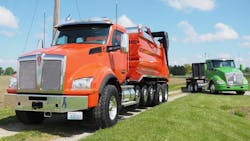If you're looking for economic barometers for trucking, Kenworth is seeing a lot of positive signs lately — but like others, predicts 2016 will be good, but not great, for Class 8 sales in the U.S. and Canada.
One indication of the Class 8 market is how many trucks are being churned out at assembly plants like Kenworth's in Chillicothe, OH. On an editors' tour on Wednesday, Plant Manager Judy McTigue noted the facility produces 80 trucks during the day shift and another 48 at night for a total of 128 per day; the lesser amount on shift two was "feathered down" a bit from last year in step with market demand, she said.
Kenworth Director of Marketing Kurt Swihart pointed out there are a number of indicators that could bode well for the heavy truck market. He noted that the company's product sales have shifted dramatically to its latest T680 on-highway and T880 vocational trucks, which were launched in 2012 and 2013, respectively.
Walking through the Chillicothe plant today, "it's very difficult to find one of our legacy models," Swihart contended. "I would guess that 90% of our current production here in Chillicothe is our T680 and T880 model lineup." With the T680 accounting for more than half of sales, the T880s are a big chunk of the rest.
For one thing, "housing and construction are doing well, and that's a big part of our business," Swihart said. "Whether it's road-building, whether it's commercial construction, whether it's housing, there's very good, robust construction activity [in the North American market] and particularly in the United States," he added.
Meanwhile, oil prices have been inching closer to the $50 mark per barrel of crude. "As oil prices dropped, it's kind of a double-edged sword for us," Swihart said. "It's good for fleets because they enjoy lower operating costs, but many of our customers are in the oilfield business, and much of that slowed down.
"Oil was priced below a sustainable level of profitable operations in many of those industries, and as oil is increasing, it's opening up some of those industries again," he continued. "That could turn from being a slight headwind for the industry back into a tailwind that will help drive business."
'Still a very healthy market'
Overall, Kenworth is projecting Class 8 sales for the U.S. and Canada will be about 10-20% lower in 2016 than last year. "Our forecast for 2016 is Class 8 will be a market of 220,000 to 250,000 units, and we expect it'll be the third-highest year in the last 10 years. It is slightly down from nearly 280,000 Class 8 units in 2015, but it's still a very healthy market," Swihart said, referencing total retail sales.
slated for completion in November.
In other good signs, Swihart pointed to truck tonnage increasing just in the last two or three months, as reported by the American Trucking Assns. Additionally, manufacturing saw a slight contraction closing out 2015 and in the first months of 2016 but is again on an upswing, he noted, citing the ISM Manufacturing Index.
"In recent months, manufacturing is expanding, and that's also good for our business," Swihart said.
![Kurt Swihart, director of marketing at Kenworth, noted that the price of oil increasing toward the $50 mark per barrel of crude 'could turn [low fuel prices] from being a slight headwind' for Class 8 truck sales 'into a tailwind that will help drive business.' Kurt Swihart, director of marketing at Kenworth, noted that the price of oil increasing toward the $50 mark per barrel of crude 'could turn [low fuel prices] from being a slight headwind' for Class 8 truck sales 'into a tailwind that will help drive business.'](https://img.fleetowner.com/files/base/ebm/fleetowner/image/2019/04/fleetowner_6411_052016_kurt_swihart_kenworth_agm_web.png?auto=format,compress&fit=crop&q=45&h=139&height=139&w=250&width=250)



